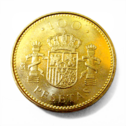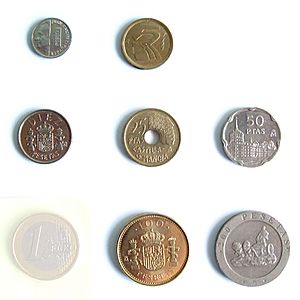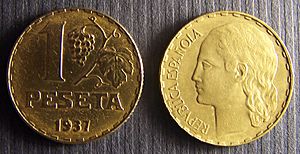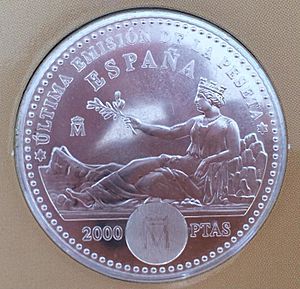Spanish peseta facts for kids
Quick facts for kids Spanish peseta |
|||||
|---|---|---|---|---|---|
|
|||||
| ISO 4217 Code | ESP | ||||
| User(s) | None, previously:
|
||||
| Inflation | 1.4% | ||||
| Source | Cámara Guipúzcoa, 1998 | ||||
| ERM | |||||
| Since | 19 June 1989 | ||||
| Fixed rate since | 31 December 1998 | ||||
| Replaced by €, non cash | 1 January 1999 | ||||
| Replaced by €, cash | 1 March 2002 | ||||
| € = | Pts 166.386 | ||||
| Subunit | |||||
| 1⁄100 | céntimo (ctm/cts) (because of inflation, céntimos were withdrawn from circulation in 1983) |
||||
| Symbol | Pta/Pts, ₧, or Pt | ||||
| Nickname |
|
||||
| céntimo (ctm/cts) |
|
||||
| Plural | Pesetas | ||||
| Coins | |||||
| Freq. used | Pts 5, Pts 25, Pts 50, Pts 100, Pts 500 | ||||
| Rarely used | Pta 1, Pts 10, Pts 200, Pts 1,000, Pts 2,000 | ||||
| Banknotes | |||||
| Freq. used | Pts 1,000, Pts 2,000, Pts 5,000, Pts 10,000 | ||||
| Rarely used | Pts 200, Pts 500 | ||||
| Printer | Fábrica Nacional de Moneda y Timbre | ||||
The peseta (pronounced "puh-SAY-tuh") was the money used in Spain from 1868 until 2002. It was also used in Andorra, a small country next to Spain, because Andorra didn't have its own money.
Contents
What's in a Name? The Peseta's Origin
The name peseta comes from the Catalan word peceta. This means "little piece" and refers to a coin. It's not from the Spanish word peso, which means "weight". People started using the word peseta around 1737 to talk about a coin worth a fifth of a peso.
The Peseta's Symbols
The Spanish peseta didn't have one special symbol like the dollar sign ($). People usually wrote "Pta" for one peseta or "Pts" for many pesetas. Sometimes, you might see "Pt" or "Ptas".
On old Spanish typewriters, there was often a single key that typed "Pts". This was a quick way to write the abbreviation. Later, computers also had a special "peseta symbol" (₧) in their early systems. This symbol looks like a "P" with a stroke through it or a combined "Pts". However, it was rarely used and became outdated when the euro arrived.
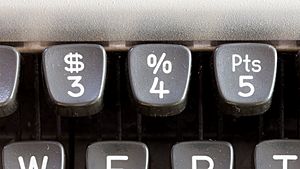
How the Peseta Was Divided
The peseta was divided into 100 smaller parts called céntimos. You could also think of it as 4 reales. However, because of inflation (when money buys less over time), céntimos coins stopped being used in 1983. The last coin worth less than one peseta was a 50 céntimos coin made in 1980.
A Brief History of the Peseta
The peseta officially became Spain's money in 1868. At that time, Spain wanted to join the Latin Monetary Union. This was a group of European countries that agreed to use similar money standards. Spain didn't formally join, but its money was very similar to theirs. One peso duro (a type of Spanish dollar) was equal to 5 pesetas.
The peseta was based on the value of silver and gold. Later, only the gold standard was used.
The Peseta Through Tough Times
In the early 1900s, especially after World War I, the Latin Monetary Union broke apart. The peseta's value changed a lot during this time.
During the Spanish Civil War (1936-1939), gold and silver coins were removed from circulation. New coins made of copper-nickel were introduced.
In 1959, Spain joined the Bretton Woods System. This system linked the peseta's value to the United States dollar. For example, Pts 60 was equal to US$1. Later, in 1967, the value changed to Pts 70 for US$1.
Spain experienced high inflation for many years after the Civil War. This meant prices went up, and money lost its value. Because of this, larger banknotes were introduced. For example, the Pts 5,000 note appeared in 1976.
Changes in Coins and Notes
In 1982, Spain hosted the 1982 FIFA World Cup. A special series of coins was made to celebrate this event. In 1983, all the small céntimo coins were removed from use. Larger notes like Pts 2,000 and Pts 10,000 were introduced.
By 1992, Pts 200 and Pts 500 notes were replaced by coins. This made Pts 1,000 the smallest banknote. Coins then ranged from Pta 1 to Pts 500. More special coins were made in 1992 for the 1992 Summer Olympics in Barcelona and Seville Expo '92.
Spain faced an economic downturn in the early 1990s. The peseta's value dropped three times. For example, it went from Pts 100 to Pts 130 for US$1.
All coins from the Franco era were removed in 1997. The peseta's value was then linked to the euro on January 1, 1999.
Peseta Coins
From 1868 to 1982, Spanish coins had a unique dating system. There was a main date on the front of the coin. But the real date it was made could be found in a tiny six-pointed star, usually on the back. So, if a coin showed "1959" on the front but a tiny "64" in the star, it was actually made in 1964. This system stopped in the early 1980s.
Coins of the Monarchy
Coins were first made in 1869 and 1870. They included 1, 2, 5, 10, 20, and 50 céntimos, and Pta 1, Pts 2, and Pts 5.
- The 5 céntimos and 10 céntimos coins were nicknamed perra chica (small dog) and perra gorda (fat dog). People thought the lion on them looked like a dog!
- The Pts 5 coin was called duro (hard). This nickname stuck around for generations, even until the peseta was replaced in 2002. People would often say "20 duros" instead of Pts 100.
Gold coins for Pts 25 were introduced in 1876, followed by Pts 10 in 1878. Gold coin production stopped in 1904.
Coins of the Second Republic and Civil War
In 1934, the Second Spanish Republic made its first coins. These coins removed symbols related to the monarchy. A Pta 1 coin made of brass in 1937 was nicknamed La Rubia (The Blonde) because it had a woman's face and a golden color.
During the Spanish Civil War, both sides (Republicans and Nationalists) made their own local coins.
Coins of the Franco Era
The first Pta 1 coins with the face of Francisco Franco were made in 1947. Other coins like Pts 5, Pts 25, and Pts 50 followed. In 1966, Franco's profile on the coins was updated to show a more recent image of him.
Coins After Democracy Returned
When Juan Carlos became king, his portrait replaced Franco's on coins. In 1982, many coins were redesigned to celebrate the 1982 FIFA World Cup.
Later, the Pts 100 banknote was replaced by a coin. New coins like Pts 10 and Pts 200 were introduced. In 1989, the Pta 1 coin became much smaller. The Pts 5 coin also became smaller, and the Pts 25 coin got a hole in the middle.
The Pts 50 coin, introduced in 1989, had a unique Spanish flower shape. This shape was later used by many other countries for their coins, including the 20-cent euro coin.
The last peseta coins were made until June 19, 2001, just before the euro was introduced.
| Value | Equivalent in euros (€) | Diameter | Weight | Composition |
|---|---|---|---|---|
| Pta 1 | 0.006 (0.01) | 14 mm | 0.55 g | Aluminium |
| Pts 5 | 0.03 | 17.5 mm | 3 g | Aluminum-bronze |
| Pts 10 | 0.06 | 18.5 mm | 4 g | Copper-nickel |
| Pts 25 | 0.15 | 19.5 mm | 4.25 g | Aluminum-bronze |
| Pts 50 | 0.30 | 20.5 mm | 5.60 g | Copper-nickel |
| Pts 100 | 0.60 | 24.5 mm | 9.25 g | Aluminum-bronze |
| Pts 200 | 1.20 | 25.5 mm | 10.5 g | Copper-nickel |
| Pts 500 | 3.01 | 28 mm | 12 g | Aluminum-bronze |
The Pts 50 coins issued between 1990 and 2000 were the first that featured the Spanish flower shape.
 |
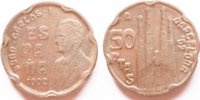 |
Spanish Euro Coins
When Spain adopted the euro, it started making its own euro coins. These coins have different designs on one side, but the other side is the same across all euro countries.
- The 1, 2, and 5 cent coins show the Cathedral of Santiago de Compostela.
- The 10, 20, and 50 cent coins feature the famous Spanish writer Miguel de Cervantes.
- The 1 and 2 euro coins show the face of King Juan Carlos I or King Felipe VI.
Peseta Banknotes
The Bank of Spain started printing peseta banknotes in 1874. They made notes for Pts 25, Pts 50, Pts 100, Pts 500, and Pts 1,000.
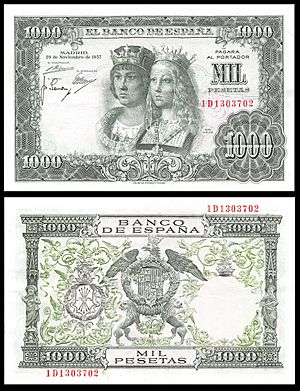
During the Civil War, both sides printed their own versions of Bank of Spain notes. After the war, from the 1940s, common notes were Pta 1, Pts 5, Pts 25, Pts 50, Pts 100, Pts 500, and Pts 1,000. The smaller notes (Pta 1, Pts 5, Pts 25, Pts 50) were replaced by coins by the late 1950s.
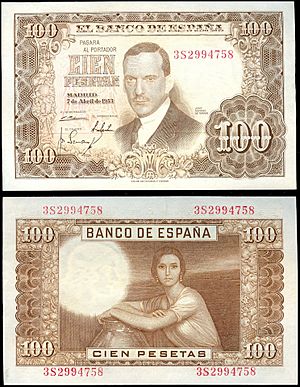
In 1978, a Pts 5,000 note was introduced. The Pts 100 note was replaced by a coin in 1982. Then, Pts 1,000 notes came out in 1983, Pts 200 in 1984, and Pts 10,000 in 1987. The Pts 200 and Pts 500 notes were replaced by coins in 1986 and 1987.
The last series of banknotes was printed between 1982 and 1987. These were the notes used until the euro arrived.
| Image | Value | Equivalent in euros (€) | Dimensions | Main colour | Portrait |
|---|---|---|---|---|---|
| [1] | Pts 200 | 1.20 | 120 × 65 mm | Orange | Leopoldo Alas |
| [2] | Pts 500 | 3.01 | 129 × 70 mm | Dark blue | Rosalía de Castro |
| [3] | Pts 1,000 | 6.01 | 138 × 75 mm | Green | Benito Pérez Galdós |
| [4] | Pts 2,000 | 12.02 | 147 × 80 mm | Red | Juan Ramón Jiménez |
| [5] | Pts 5,000 | 30.05 | 156 × 85 mm | Brown | Juan Carlos I of Spain |
| [6] | Pts 10,000 | 60.10 | 165 × 85 mm | Gray | Juan Carlos I of Spain and Felipe, Prince of Asturias |
The very last series of banknotes was printed in 1992:
| Image | Value | Equivalent in euros (€) | Dimensions | Main colour | Portrait |
|---|---|---|---|---|---|
| [7] | Pts 1,000 | 6.01 | 130 × 65 mm | Green | Hernán Cortés and Francisco Pizarro |
| [8] | Pts 2,000 | 12.02 | 138 × 68 mm | Red | José Celestino Mutis |
| [9] | Pts 5,000 | 30.05 | 146 × 71 mm | Brown | Christopher Columbus |
| [10] | Pts 10,000 | 60.10 | 154 × 74 mm | Gray | Juan Carlos I of Spain and Jorge Juan y Santacilia |
The Andorran Peseta
Andorra, a small country in the Pyrenees mountains, also used the peseta. It was called the Andorran peseta (ADP) but had the same value as the Spanish peseta. Andorra started issuing its own paper money in 1936, which was backed by Spanish banknotes.
The Euro Replaces the Peseta
The peseta was officially replaced by the euro on January 1, 1999, for things like bank transfers. Euro coins and banknotes started being used in January 2002. By March 1, 2002, the peseta was no longer legal money in Spain or Andorra. The exchange rate was fixed: €1 was equal to Pts 166.386.
People could exchange their old peseta notes (issued since 1939) and coins for euros at the Bank of Spain until June 30, 2021. Even after that date, a lot of pesetas were never exchanged!
See Also
 In Spanish: Peseta para niños
In Spanish: Peseta para niños
- Commemorative coins of Spain
- Economy of Spain
- Euro (since 1999)
- Spanish euro coins


